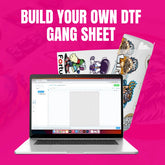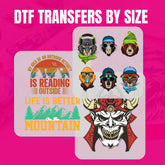Decal Transfers vs. DTF Transfers: What’s the Difference?
Two popular printing methods for adorning hard surfaces, clothing, and accessories are DTF transfers and decals. Both may create brilliant, outstanding designs, even if they approach things differently and have different benefits. Understanding these differences helps you choose the course of action your project will follow.
While some find iron-on decals straightforward, others appreciate custom DTF transfers for their durability and flexibility. The suitable method depends on factors like application method, cost, and durability. To help you decide which best suits your needs, this article breaks out what you need to know about DTF and decal transfers.
Application Process
Decal transfers require more hand labor. Designs are printed on a surface after being cut out from vinyl or special decal paper. The type of decal used will depend on the type; glue, water, or heat could all be utilized. Iron-on decals are popular variations that bond cloth with heat from a home iron or heat press.
On the other hand, DTF transfers print straight onto a film, covers it with a designated adhesive powder, and then cures it. The pattern is next heat-pressed into cloth. Unlike decals, DTF transfers neither stacking nor cutting is not required. For big purchases especially, this simplifies and speeds application.
Durability and Longevity
One of their primary differences is the degree to which these methods hold up over time. Decal transfers—especially those made from vinyl—can last a long time, but after numerous washings, they may start to peel or crack. This is particularly true with iron-on decals, which may fade with time depending on their placement or upkeep.
By contrast, DTF transfers are supposed to last. The ink is buried into the fabric fibers, which helps to prevent splitting, fading, and peeling. Tests of DTF heat transfers have shown they withstand more than 50 washes without substantial damage. Generally speaking, DTF transfers make the more practical choice for long-term durability.
Fabric and Surface Compatibility
Although they are flexible, decals work best on smooth, non-porous surfaces such as plastic, metal, and glass. Although sometimes they feel stiff, iron-on decals stick nicely on cloth. They could also find heavily textured fabrics or stretchy clothes difficult.
DTF transfers provide more liberties. They run practically on any kind of fabric, including blends, cotton, polyester, and even leather. Their direct connection with fibers helps them keep their soft, supple feel, making them the first choice of companies in apparel, activewear, and custom printing.
Color and Print Quality
Both decal and DTF transfers provide vibrant colors, even if they accomplish this with distinct techniques. Decal transfers are based on laying printable or vinyl on a transfer sheet. This sometimes results in color limits, especially in intricate designs, including minute details.
DTF transfers allow quality pigment-based inks to be applied directly to film. This results in sharper details, more vivid colors, and smoother gradients. Perfect for accurate drawings, logos, and photorealistic prints, DTF transfer sheets faithfully reproduce challenging artwork.
Cost and Production Speed
Decal transfer is sometimes the more reasonably priced choice for small jobs. They can be printed at home using a basic inkjet printer and hand-applied. This makes them readily available for handcrafted aficionados and small businesses. Still, especially for larger quantities, the procedure can take time.
First, setup costs are higher since DTF transfers require specific tools. Once the process is in place, though, output is faster and more effective. Over time, custom DTF transfers save money and time for businesses needing large quantities of high-quality prints.
Which One Should You Choose?
For do-it-yourself decoration of products like mugs, notebooks, or phone covers, decal transfers could be the simple, uncomplicated approach you need. They are excellent for small-scale cloth crafts, and iron on decals require careful application and maintenance.
DTF transfers are the finest option for durable, stretchable, vibrant, professional-quality printing. Their velvety, long-lasting finish is fantastic for clothes, personalized items, bulk printing, and mass production.
Conclusion
Custom printing allows for DTF transfers as well as decal ones. Iron-on decals offer a quick and easy way to personalize fabric, while DTF heat transfers offer a more permanent, premium solution. The suitable method will depend on the long-term durability, budget, and material you need.
For high-quality DTF transfer sheets and supplies, check out DTF Transfer Art for premium printing solutions!
- bulk dtf transfers
- bulk printing
- cost-efficient printing
- custom apparel printing
- Custom clothing printing
- custom gangsheet
- Custom Gangsheets
- custom heat transfers
- custom prints
- decal production
- decal transfer
- decal transfers
- Digital printing
- Direct-to-Film Transfer
- dtf business
- DTF gangsheet
- DTF Heat Press
- dtf print shop
- DTF Printing
- dtf transfer
- dtf transfer art
- dtf transfer film
- dtf transfer instructions
- dtf transfer paper
- dtf transfer printer
- dtf transfer sheets
- dtf transfers
- dtf transfers near me
- dtf transfers ready to press
- dtf transfers wholesale
- DTF vs Screen Printing
- DTF vs Vinyl
- DTF vs. iron-on
- dtf wholesale
- gangsheet printing
- heat press printing
- heat transfer decals
- heat transfer method
- heat transfer printing
- hoodie printing
- hot peel DTF
- iron-on decals
- model decals
- print on demand
- Printing companies
- Printing methods
- Quality printing
- Screen printing
- sticker printing
- Sublimation printing
- t shirt printing
- Transfer printing
- vinyl decals
- what is dtf transfer






